On View
Lucy Sparrow on Why Her Cuddly Felt Bodega Brings Relief From Our ‘Crazy Political Times’
The British artist's felt installation is this summer's Instagram sensation.
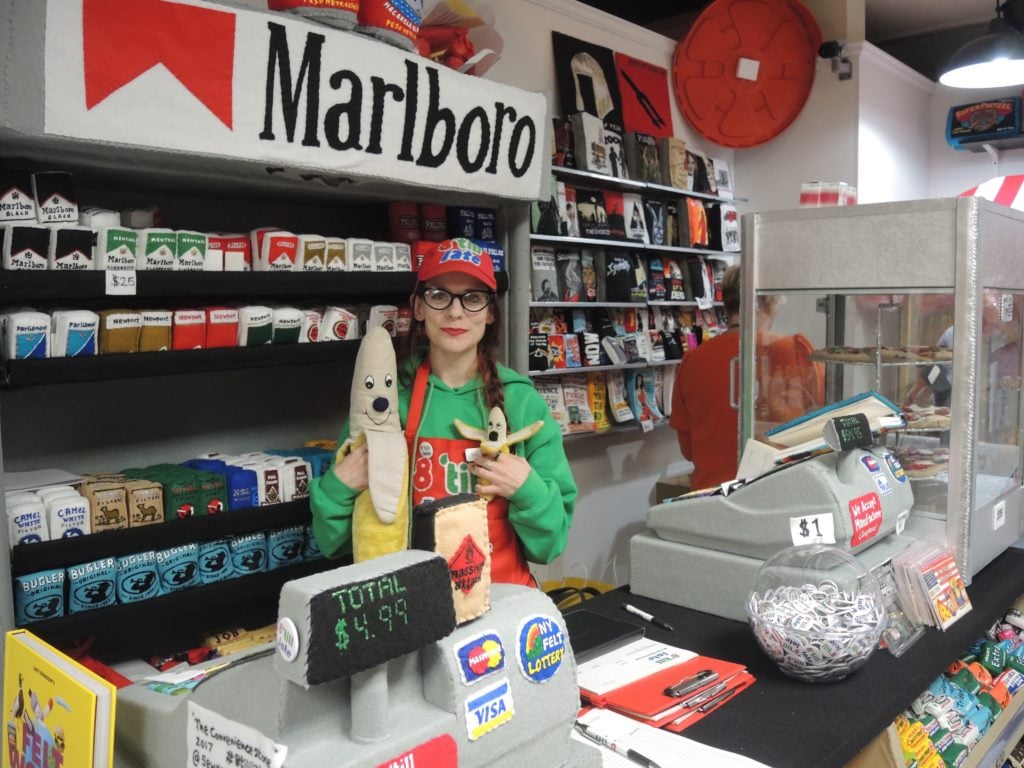
The British artist's felt installation is this summer's Instagram sensation.

Sarah Cascone

It’s rare that New Yorkers take notice of the opening of a new bodega, those ever-present convenience stores that provide the staples of life in the Big Apple—everything from beer and cigarettes and junk food to toilet paper and baby formula. They’ll even make you a sandwich or a cup of coffee.
The city’s newest bodega, however, stands out from the pack. It carries everything you’d expect, but with a major twist: Its entire stock is made from felt. That’s because this store, located at the Standard Hotel, is actually a massive art piece by British artist Lucy Sparrow. Called 8 ‘Till Late, it’s an updated version of Cornershop, her blockbuster 2014 London work based on the bodega’s British equivalent.
The installation, which opened June 5, has been an immediate hit on this side of the Atlantic as well—so much so that the shop will be closed on June 12 and 13 so that Sparrow can restock to meet demand. She’s made 9,000 felt sculptures, cuddly facsimiles of cleaning products, cereals, candy bars, a fully-stocked deli counter, and even the classic bodega cat. (To put the project’s scale in perspective, the sculptures weigh a collective nine tons.)
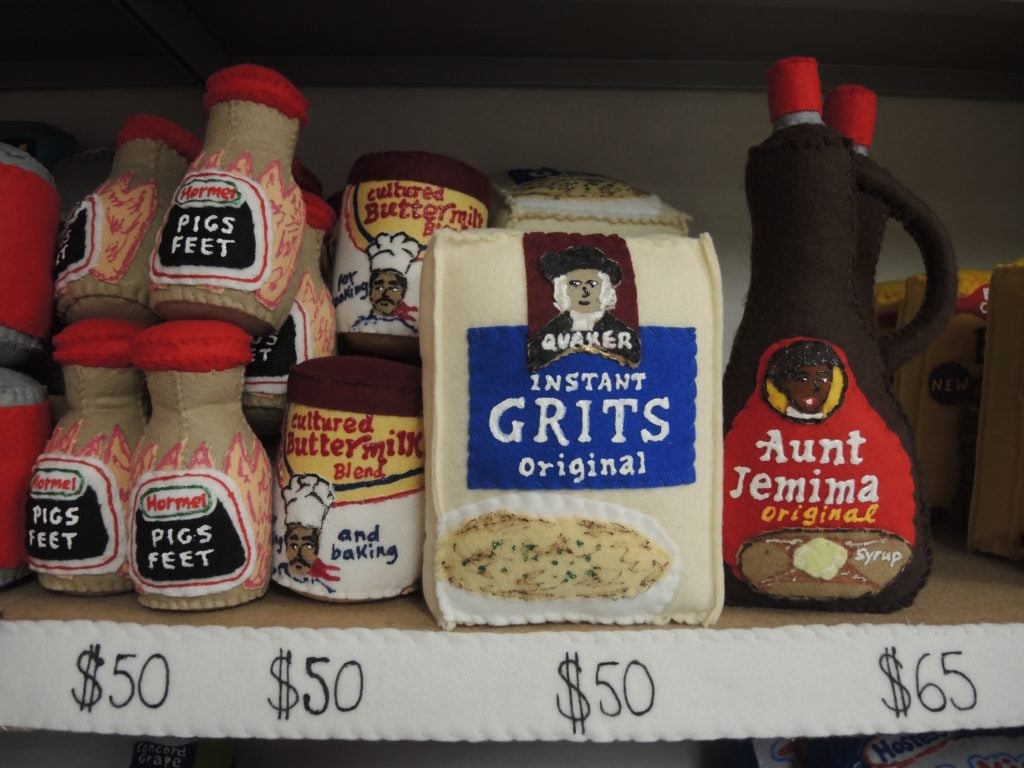
Lucy Sparrow, 8 ‘Till Late. Courtesy of Sarah Cascone.
Taking this New York institution to the next level, Sparrow’s bodega is stocked with pretty much everything you could hope to encounter at your neighborhood store, past, present, and future. This includes both beer and liquor—sold in different establishments under New York state law—vegetables, newspapers, and even videos.
Each piece is for sale, starting at just $15 for a cute little pink lighter, although if you like surprises there are also $5 mystery prizes in Sparrow’s felted vending machine, and $1 pins with the store logo. “How many galleries in Chelsea can you leave with a $15 original work of art?” the artist asked artnet News. (On the other end of the spectrum, of course, buying the entire installation will run you a cool half a million dollars.)
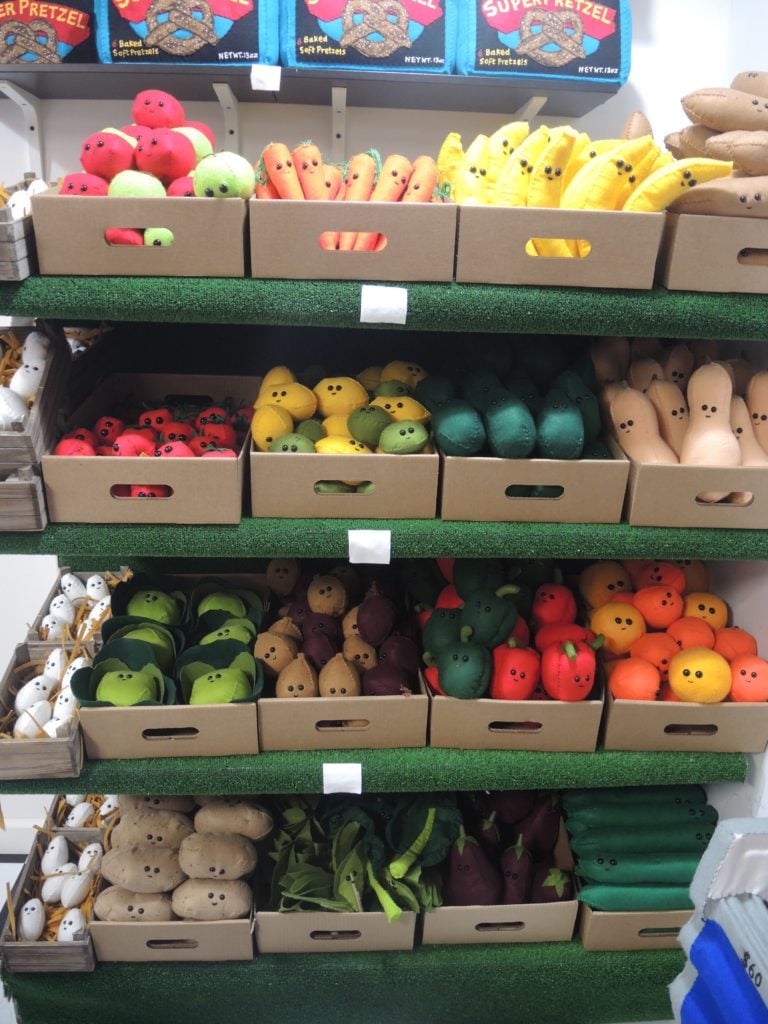
Lucy Sparrow, 8 ‘Till Late. Courtesy of Sarah Cascone.
Some nine months in the making, 8 ‘Till Late is in many ways the culmination of years of effort, Sparrow’s inspiration dating back to her childhood. “I was about eight years old and I remember sewing a packet of crisps,” recalled the artist, who was sewing before she was making art. “I thought it was amazing that you could make cuddly food.”
Part of the project’s appeal undoubtedly lies in viewers’ own childhood memories, of the stuffed animals and toys that they are expected to give up as adults. Sparrow even likens her work to regression therapy.
The bodega artwork, which opened following a successful Kickstarter fundraising effort, also hearkens back to the city’s more affordable past—the historic Meatpacking district is now a trendy tourist destination, with luxury shops increasingly replacing the businesses that gave the neighborhood its name.
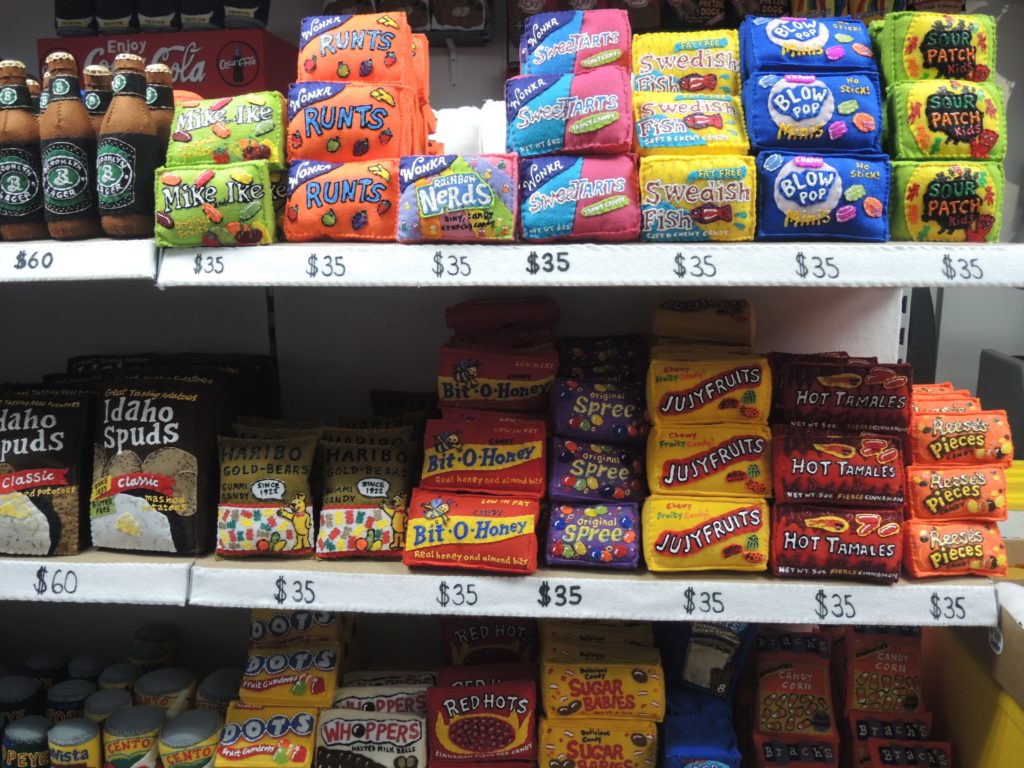
Lucy Sparrow, 8 ‘Till Late. Courtesy of Sarah Cascone.
Sparrow’s installation serves as a reminder that as ubiquitous as your neighborhood bodega may seem, such independent business are in constant danger of being forced out by larger chains or more high-end businesses that can easily afford New York’s ever-rising rents. In other words, it’s a very soft and cuddly commentary on the evils of gentrification.
What isn’t immediately apparent, but becomes increasingly clear upon further exploration of the shop is that while it may be tempting to categorize Sparrow as a fiber artist, or a sculptor, she is also very much a painter. Each of the labels on her many packaged goods are painstakingly hand-painted—the overall effect is so convincing that at least one visitor actually mistook the installation for a real store, attempting to pick up some Tylenol.
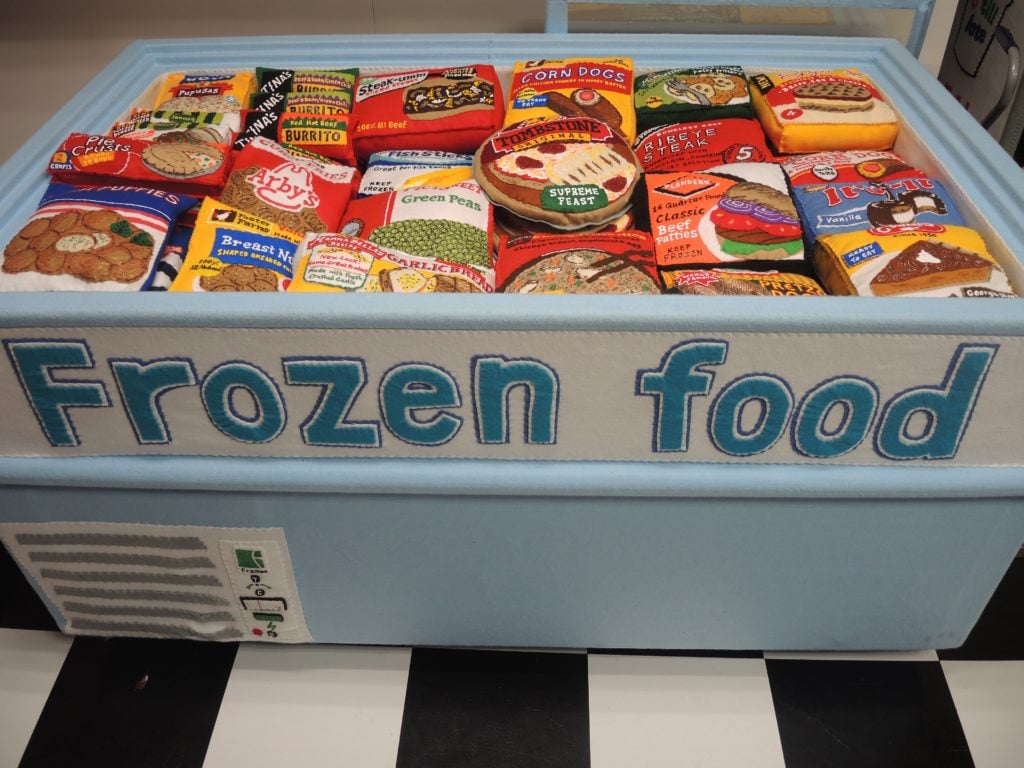
Lucy Sparrow, 8 ‘Till Late. Courtesy of Sarah Cascone.
Although the exhibition is her first American solo show, you may have spotted Sparrow’s work at the March 2016 edition of New York’s Affordable Art Fair, where Tel Aviv’s Mika Gallery featured display cases stocked with her stuffed sculptures, grouped into genres like junk food.
Later that year during Art Basel in Miami Beach, London’s Lawrence Alkin Gallery dedicated a portion of their booth at SCOPE Miami Beach to Sparrow’s Deli, the artist’s pitch-perfect sandwich shop, complete with a beautifully illustrated felt menu board hawking meatball heroes and other delicacies. Following those stateside test-runs, 8 Till Late is Sparrow’s largest installation to date.
There is also a back room that serves as a more traditional showcase of Sparrow’s artwork, a felted shopping cart filled with her grocery sculptures, and wall-mounted arrangements of detergents, ketchup bottles, and Warhol-tinged Campbell’s soup cans.
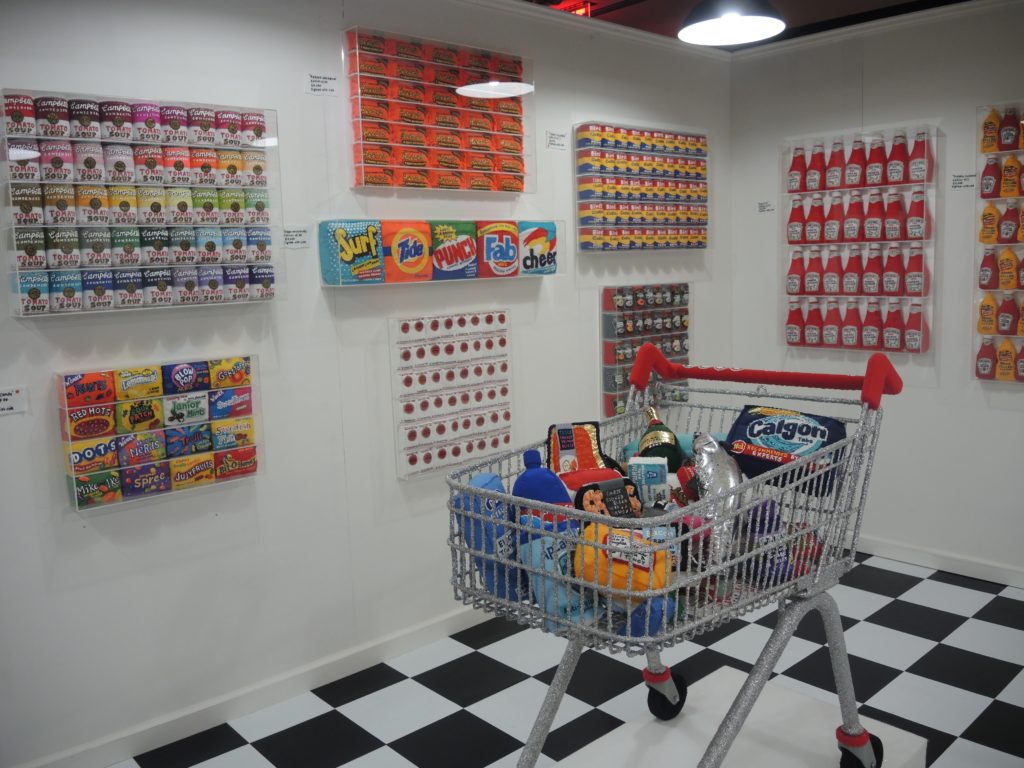
Lucy Sparrow, 8 ‘Till Late. Courtesy of Sarah Cascone.
“It’s offering people a chance to see the works in a gallery context,” Sparrow explained to artnet News. “I love doing installations, but I’m also aware that most people can’t have one in their house unless it’s really big. It’s able to exist in both areas.”
Keeping the “store” open late to chat with us, Sparrow spoke about the ambitious scale of 8 ‘Till Late, her development as an artist, the appeal of her work, and her ambitious plans for the future.
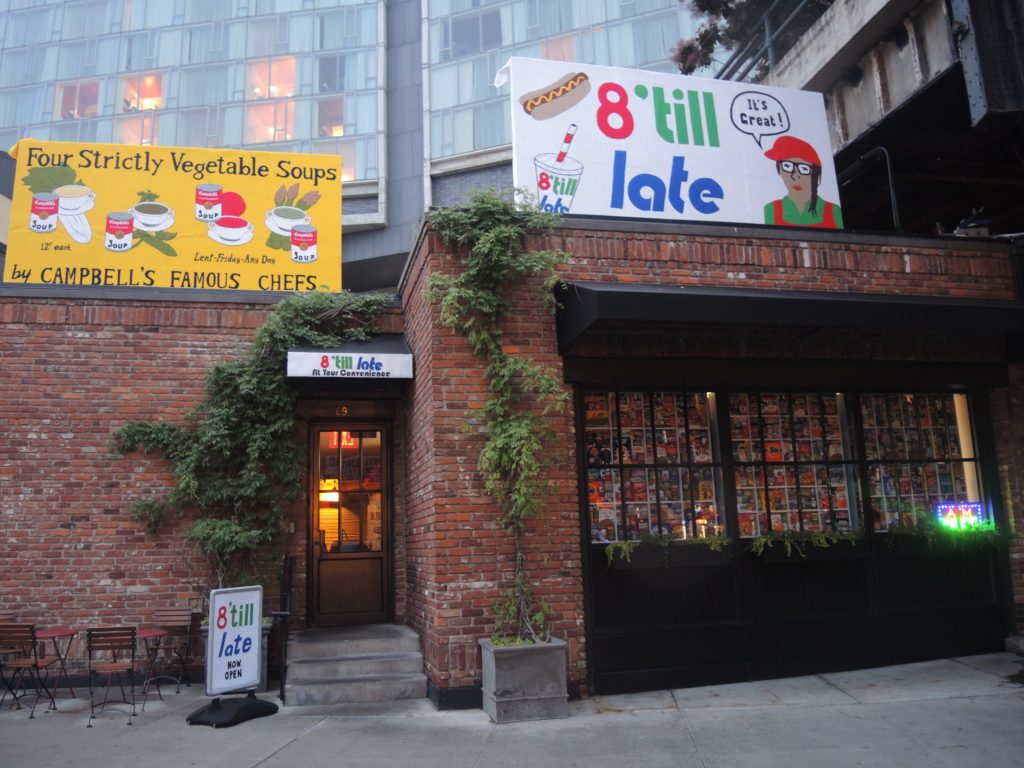
Lucy Sparrow, 8 ‘Till Late. Courtesy of Sarah Cascone.
How has the response from New Yorkers been?
It’s been absolutely incredible. People have come in and just screamed with excitement, which is the perfect response! We’re going through some dark times at the moment, in England, so it’s nice that this is light relief in contrast to crazy political times. It may appear fluffy and lovely on the surface, but it’s offering an alternative.
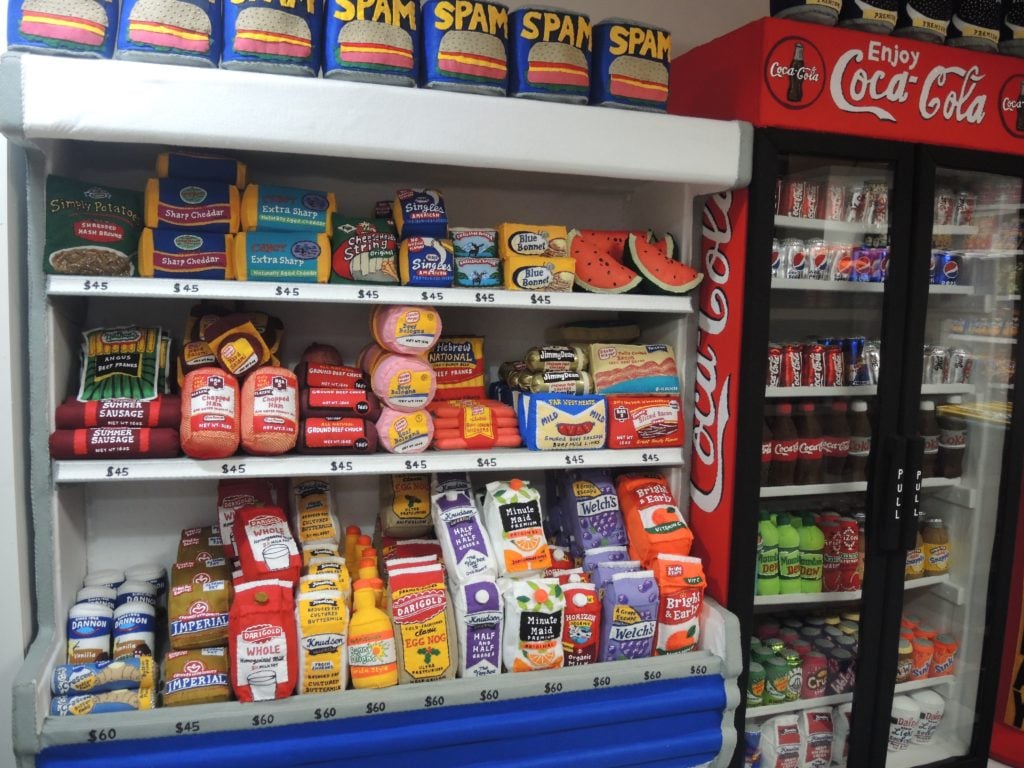
Lucy Sparrow, 8 ‘Till Late. Courtesy of Sarah Cascone.
You had nine months to make 9,000 objects. Did you ever think it wasn’t going to get done in time?
Yes! I kept having to adjust deadlines. I had this Google calendar and I was literally scheduling by the hour, because I thought I wasn’t going to get it done. It was scary. I was painting beers the morning I got onto the plane!
Was it one of those things where the more you worked on it, the more the scope of it grew, where it was kind of never ending?
Yes. Completely. I’d be looking at some more bodega pictures and be like, “Oh God!” Or I’d be asking some advice from a New Yorker and they’d be like, “you’ve gotta have this, you can’t not have this, or it’s not a bodega.” So there was stuff being added to it all the time.
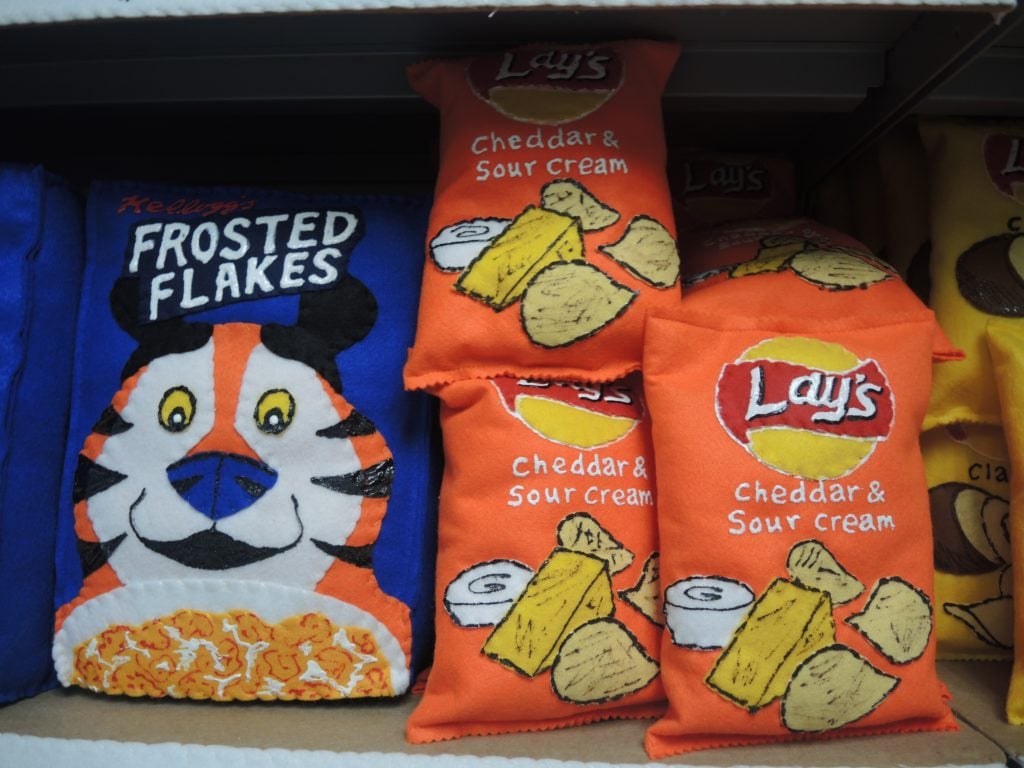
Lucy Sparrow, 8 ‘Till Late. Courtesy of Sarah Cascone.
Do you feel like you’re the consummate expert on bodegas now? It’s a very New York institution, but even New Yorkers have differing opinions of what exactly constitutes a bodega, other than that you kind of know it when you see it.
I think I know more than the average Brit, so that’s good! Our UK equivalent obviously is the corner shop, which is kind of like a bodega, but with more newspapers.
I’ve been told by a lot of people that I’ve got it right, so that’s all that I was interested in. There’s nothing worse than going to something and it’s like, “Oh, they couldn’t be assed to do the research,” you know? I really tried, so hopefully I’ve got it.
Someone pointed out that there’s one switch on the meat slicer that’s currently got a European symbol on it, and I was like, “Noooooo…”
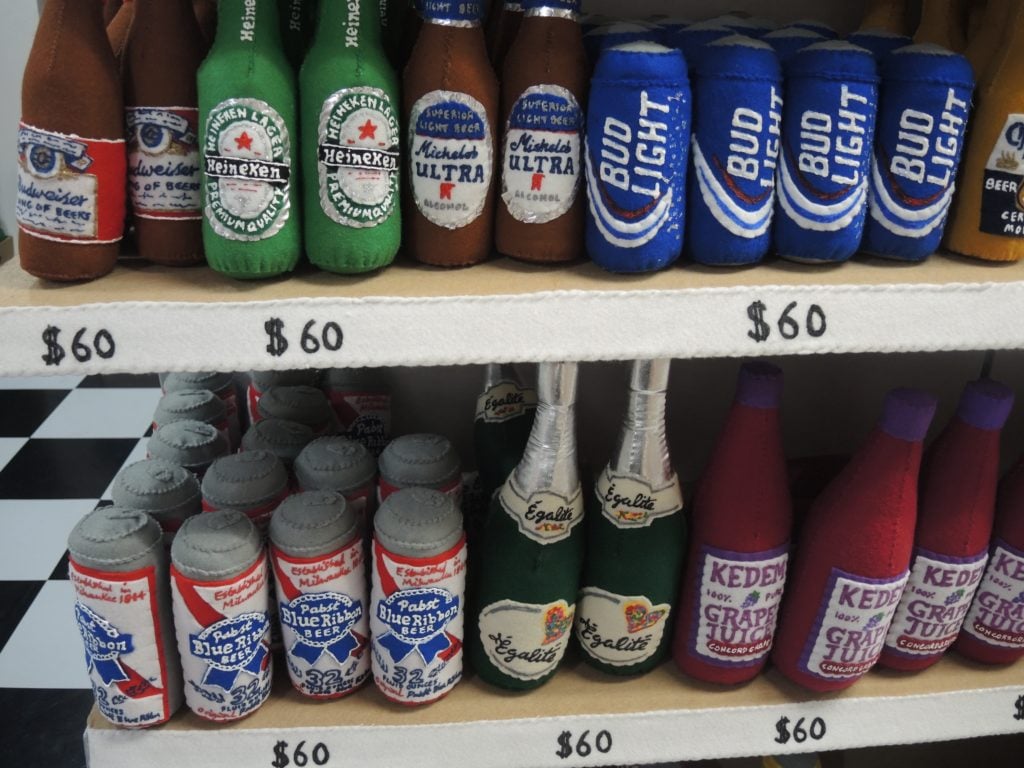
Lucy Sparrow, 8 ‘Till Late. Courtesy of Sarah Cascone.
Maybe it was imported?
It might have been! That’s exactly it!
Why has the shop become such a fruitful subject matter for you?
It’s a place that you go pretty much every day of your life. The only place that you probably spend more time in is your own home or office. But your local bodega or corner shop, that’s your home away from home, that’s your lifeline, you know? That must be why it’s so intriguing. I’m fascinated by packaging labels, the way that things are presented, and this possibility of owning everything in the shop.
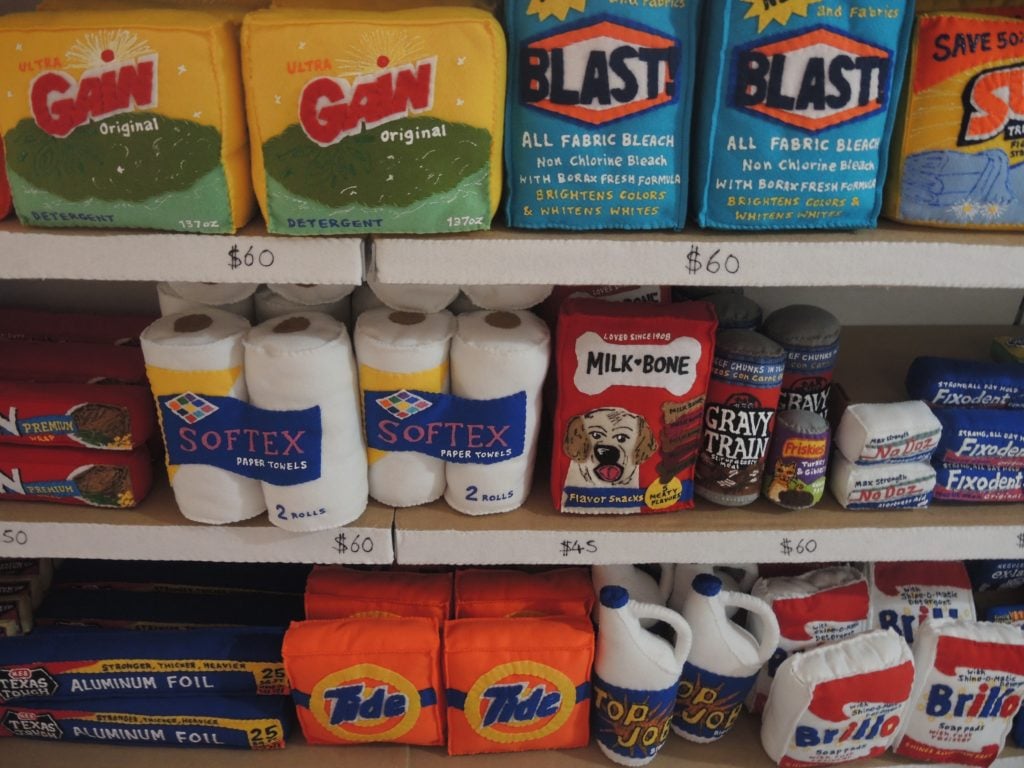
Lucy Sparrow, 8 ‘Till Late. Courtesy of Sarah Cascone.
How much would it cost if someone bought the entire installation?
It’s $500,000, which for a whole installation is actually not that bad. You could get yourself one hundredth of a Jeff Koons sculpture for the same price, maybe!
How have sales been so far?
It’s been really busy! The most popular item so far has been the Moet champagne, which sold out almost right away.
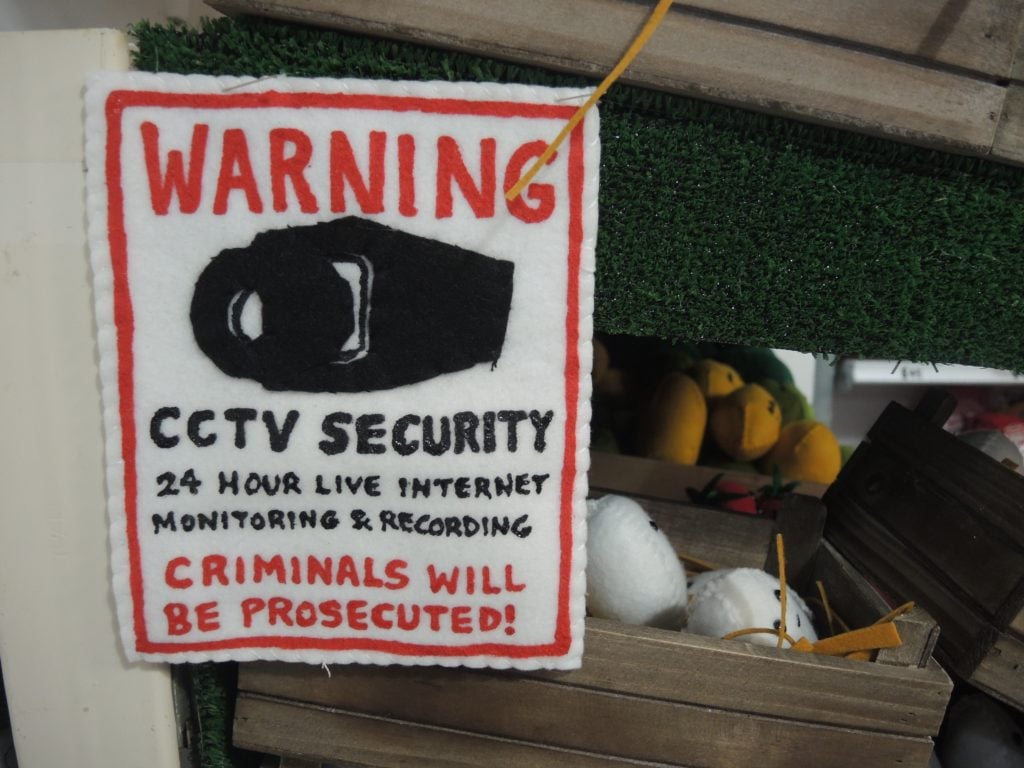
Lucy Sparrow, 8 ‘Till Late. Courtesy of Sarah Cascone.
That’s a little fancy for a bodega!
Yeah, I wanted to have it though. I’ve sold a lot of Brooklyn Lager, Campari, Jameson, Friskies cat food, and, weirdly, Vagisil. I don’t know! I can’t explain that. But tampons were one of my best selling items at the Cornershop.
Luckily, you’ve found a subject matter that really speaks to people. But how do you build on the success of 8′ Till Late?
Bigger. Always bigger! I’m not short of ideas, at all. I’m short of time—always short of time.
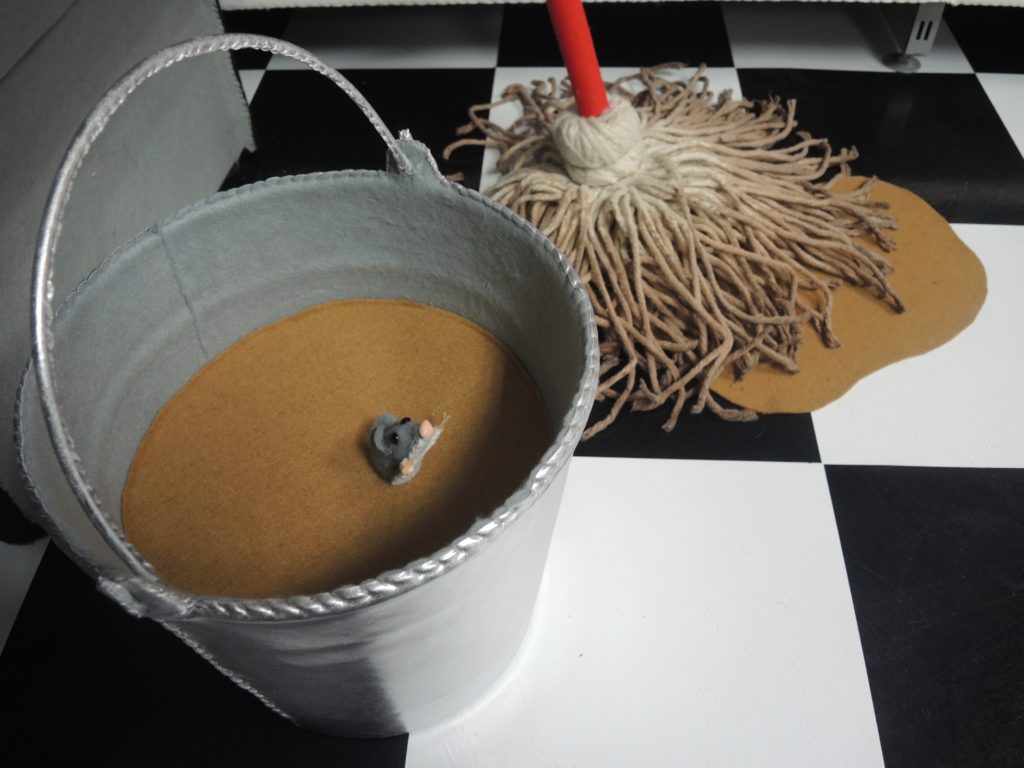
Lucy Sparrow, 8 ‘Till Late. Courtesy of Sarah Cascone.
“Lucy Sparrow: 8 ‘Till Late” is on view at the Standard, 69 Little West 12th Street, June 6–30, 2017.